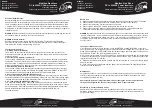
Unit 2, 1 St James Place, Seven Hills ,NSW, 2147, Australia
Controls and indicators:
1.
ON/OFF Switch (all models):
The ON/OFF switch turns the control circuit in the power inverter on and off. It does not
disconnect power from the power inverter. Always leave this switch in the off position before
operating inverter.
2.
Over temp LED indicator (all models):
The over temp LED indicates that the power inverter has shut down because it has become
overheated. The power inverter may overheat because it has been operated at power levels
above it’s rating, or because it has been installed in a location, which does not allow it to
dissipate heat properly. The power inverter will restart automatically once it has cooled off.
3.
Overload LED indicator (all models):
The overload LED indicates that the power inverter has shut itself down because its output
circuit has been short-circuited or drastically overloaded. Switch the ON/OFF switch to OFF,
correct the fault condition, and then switch the ON/OFF switch back to ON.
4.
Input voltage display (INV1000/1500/2500 only):
This bar graph displays the status of the input voltage from the supply source. Under normal
operating conditions the bar graph should display in the green area. Should the voltage either
increase or decrease the bar graph will display in the red areas and the unit will shut down.
5.
AC Load display (INV1000/1500/ 2500 only):
This bar graph displays the AC power drawn from the power inverter. It indicates the load in
Watts. Under normal operating conditions the bar graph should display in the green or orange
bars of the display. If the load is excessive the number of bars being displayed will increase.
Should all the bars illuminate, the unit will shut down to protect itself as this is in
overload condition.
WARNING! Shock Hazard!
Before proceeding further, ensure that the Inverter is NOT connected to any Batteries,
and that all wiring is disconnected from any electrical Sources. Do not connect the output
Terminals of the Inverter to an incoming AC source.
Electrical Requirements:
Before installing your inverter, please make sure that you have appropriately sized batteries. A
battery that is too small in capacity will not allow the inverter to perform to its full specification.
The DC cabling must be connected to the correct polarity terminals of the battery bank. (Red
= Positive, Black = Negative). DO NOT extend the DC cable length to the inverter unless you
are prepared to increase the diameter of the cable. If this is necessary consult your supplier or
installer for advice.
WARNING!
Reverse polarity connection will blow the internal fuse and may damage the inverter
permanently. Reverse polarity is not covered by warranty.
Page 2 of 4
Models:
INV600-12, INV600-24
INV1000-12, INV1500-24,
INV1500-12, INV2500-24,
INV2500-12
Modified Sine Wave
DC to 240VAC Power Inverters
12VD
Operating Instructions
Please read these instructions before use
Unit 2, 1 St James Place, Seven Hills ,NSW, 2147, Australia
Page 3 of 4
Models:
INV600-12, INV600-24
INV1000-12, INV1500-24,
INV1500-12, INV2500-24,
INV2500-12
Modified Sine Wave
DC to 240VAC Power Inverters
12VD
Operating Instructions
Please read these instructions before use
Maintenance:
Very little maintenance is required to keep your inverter operating properly. You should clean the
exterior of the unit periodically with a dry cloth to prevent accumulation of dust and dirt. Do NOT
use cleaning chemicals or water.
Remember to remove all plugs from GPO’s when cleaning the inverter and at the same
time, check and tighten the screws if necessary on the DC input terminals.
Helpful Tip to Conserve Battery Power:
Should the inverter not be used over an extended period of time, it is recommended that the
battery be disconnected from the inverter. This will ensure battery will not be drained over the
period of non-usage.
Before Use:
1.
Unpack and inspect the power inverter, check to see that the power switch in the OFF position.
2.
Connect the DC POSITIVE cable to the Positive (POS+) terminal on the battery.
3.
Connect the cable to the Positive terminal on the inverter.
4.
Connect the DC NEGATIVE cable to the Negative terminal on the inverter.
5.
Connect the cable to the Negative (NEG-) terminal of the battery. This should be the last
connection made. A spark when making this final connection is normal.
WARNING!
• Make sure all the DC connections are tight. Loose connections will overheat and could
result in a fire hazard. • Do not operate the power inverter without connecting it to ground if used on
a building site. Electrical shock hazard may result. • You may observe a spark when you make this
connection. Do not make this connection in the presence of flammable fuse Explosion or
fire may result.
Testing Unit after Connection:
1.
Set the power switch to the ON position. Check the METERS and INDIDCATORS on the front
panel of the inverter. The voltage bar graph will indicate the level of voltage from power source. If bar
graph (1000/1500/2500) or LED (600W) does not indicate voltage, check the power source and the
connections to inverter. The other indicators should be off.
2.
Set power inverter switch to the OFF position. The indicator lights may blink and the internal alarm
may sound momentarily. This is normal. Plug the test load into the AC GPO on the front panel of the
inverter while still in the “off” position.
3.
Set power inverter switch to the ON position and turn the test load on. The inverter should supply
power to the load.
4.
If you are operating several loads from the power inverter, switch them on separately after the
inverter has been switched on.




















